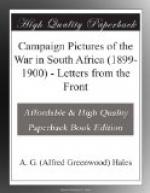That day our scouts captured one Free State flag from the enemy; the Yeomanry and mounted infantry did not succeed in their efforts to turn the Boers’ left flank, but they checked the enemy from advancing in that direction, which was an important item in the day’s work. We did not want the Boer left to overlap our right; had they done so they could then get behind us and harass our convoys coming from the direction of Bethany railway station. We had very little dread of them turning our left flank, because we knew that General French was moving towards us on that side from Bloemfontein, with the object of getting the Boers on the inside of two forces, and so giving them no chance of escape. We had only a few men wounded, one petty officer of the Scouts killed, and a negro driver killed, which was simply marvellous when one considers the terrible amount of ammunition used during the day. That night all the correspondents had to sleep, or try to sleep, with the transport. It was a wretched night; we knew the Boers had the range, and we fully expected to get a hot shelling between darkness and dawn, but, curiously enough, the foe kept their guns still all the night But the suspense made the night a weary one.
The following day was Sunday, and at a very early hour our scouts informed us that the Boers had made a wide detour towards Wepener, and had overlapped our right flank. They slipped up into a kopje, which would have enabled them to enfilade our position in a most masterly manner; but before they could get their guns there our artillery was at them, and the kopje was literally ploughed up with shells. It was too warm a corner for any man on earth to attempt to hold, and they soon took their departure, falling back in good order, and leaving no dead or wounded behind them. The Yeomanry had advanced on the kopje, under the protection of the shell firing, and when close to the position they fixed bayonets and dashed up the hill; but when they topped it they found that the Boers had retired. It was a quick bit of work, neatly and expeditiously done. Had the Boers held the hill long enough to get their guns in position they would have played havoc with us, for they could then have swept our whole line. From morning until night-fall we kept at them with our big guns; whenever a cloud of dust arose from




